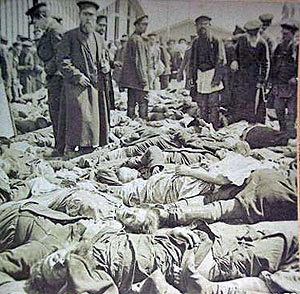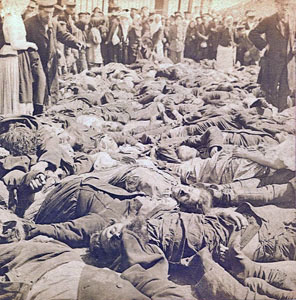 Khodinskii Field panic aftermath 18/30 May 1896. |
Like his grandfather Nicholas I, Alexander III did not expect to become tsar. However, following the death of his older brother in 1865, the new heir received sixteen years of mediocre tutoring prior to his accession to the throne in 1881, following the assassination of his father, Alexander II. Unfortunately, Alexander's tutor had been Konstantin Pobedonostsev, a died-in-the-wool conservative. |
Pobedonostsev was the most prominent and articulate defender of Russian autocracy between 1881 and 1905. He rose to prominence as a jurist, but his influence at court stemmed from his years as the tsar's tutor, and by the time of Alexander III's coronation, Pobedonostsev was ober-prokurator of the Holy Synod, lay head of the Russian Orthodox Church. From the beginning, Pobedonostsev helped Alexander formulate reactionary policies, and exercised considerable leverage over high-level government appointments. |
 Khodinskii Field panic aftermath 18/30 May 1896. |
Pobedonostsev drafted, for instance,
Alexander III's 29 April 1881 manifesto, which
stated that the autocracy would be maintained in unaltered form. He also converted the ministries of
education, interior, and printing affairs (censorship) into engines of
reaction. In protest, the last two
reform-minded ministers from the previous reign, Mikhail Loris-Melikov and Dmitrii Miliutin,
submitted their resignations (probably forced).
The reactionary thought of Pobedonostsev was best expressed in his 1896 book Reflections of a Russian Statesman, a work containing one of the most thoroughgoing critiques of democracy ever published. At the time, democracy was not an option for Russia, but his vehement rejection of it as “the great falsehood of our time,” had the unfortunate spillover effect of even damping down Russian nationalism (in favor of the author's dynastic conception of autocracy), which could have become a bolster for the regime. The extremes of reaction were seen in such steps as the gentry-controlled bureaucracy of the land captaincies and the rollback in zemstvo and municipal government representation for all classes except the gentry, wherein voter lists were cut by two-thirds.
The only progressive aspect of Alexander III's reign was the conscious support finally given by the government to industrialization. Ironically, this probably hastened the demise of the autocracy which fostered capitalist development but which was totally unable to cope with the realities of the industrial age that resulted. Russia's economic development under Alexander III was directed by the tsar's three able ministers of finance. The first, Nikolai Bunge, created a workable system of taxation that greatly increased the state's revenues, while also taking steps to increase peasant mobility, which enabled the creation of an urban working class. His successor, Ivan Vyshnegradskii, was fixated on exports as a means of economic growth. For Russia, this meant greatly increased grain exports, but when famine struck in the early 1890s, Vyshnegradskii's policies were seen as short-sighted, and he was dismissed. Sergei Witte, appointed minister of finance in 1891, greatly intensified Russian railroad construction and made the railways, for the first time, serve the needs of industry by linking manufacturing centers with their sources of raw materials (heretofore, Russian railways were designed solely to serve military and agricultural export needs).
Unlike his father, Nicholas II was ill-prepared to govern, and suffered a most inauspicious accession to power. On the day of his coronation in Moscow, over 1300 people were trampled in the Khodynka field riot. Nicholas' apparent unconcern immediately fixed a stigma upon him in the minds of many Russians, and he did little if anything during his reign to assuage the impression of being both indifferent and clueless. Nicholas soon dashed any hopes he might depart from his father's reactionary course by denouncing as “senseless dreams” the aspirations of zemstvo leaders for a more active role in national affairs. His apparent indifference to national affairs was only accentuated by Nicholas' habit of withdrawing into his family circle, especially after the birth of the hemophiliac tsarevich in 1904.
Just as Russia's political, social, and economic affairs were demanding more from him, the tsar instead retreated into the role of “first father.” Luckily, Sergei Witte was still in a position to oversee Russia's destiny. Witte's political views were never as fixed or reactionary as those of Nicholas, and since he knew from experience that the tsar lacked any leadership qualities, Witte came to believe that constitutional government would be the best option for Russia. Thus, Witte did much to engineer the constitutional period that began for Russia in 1905. Nicholas, ill-advised and vacillating as ever, granted the October Manifesto but immediately forced the resignation of Witte, its architect. Prospects for the Duma were therefore dismal from the very outset, especially when the tsar's power to control it was greatly increased by the Fundamental Laws.
See also some separate notes on Aleksandr III and Nikolai II.
- Hans Rogger, Russia in the Age of Modernisation and Revolution, 1881-1917 (1983)
- W. Bruce Lincoln, In War's Dark Shadow: The Russians before the Great War (1983)
- Kyril FitzLyon and Tatiana Browning, Before the Revolution: Russia and Its People Under the Czar (1978)
- Marvin Lyons, Russia in Original Photographs, 1860-1920 (1977)
- Robert Allshouse, ed., Photographs for the Tsar (1980)
- Petr Zaionchkovsky, The Russian Autocracy under Alexander III (1970)
- John Klier, Russia Gathers Her Jews: The Origins of the Jewish Question in Russia (1985)
- There are a number of websites with excellent photo exhibitions of Russia around the turn of the century: The Empire That Was Russia: The Prokudin-Gorskii Photographic Record Recreated, A Romanov Album, Russian Empire, 1895-1910: Photographs from stereoscopic negatives in the Keystone-Mast Collection, St. Petersburg, 1900: A Photographic Travelogue of the Capitol of Imperial Russia.
- Read an interesting account of Nicholas II as the new tsar, by E. Borges, "The New Czar and What We May Expect From Him from Harper's New Monthly Magazine, 91 (June 1895).
- A number of websites focus on a warm, fuzzy recollection of Nicholas and Alexandra: Last of the Czars, Nicholas and Alexandra - The Last Imperial Family of Tsarist Russia, The Real Tsaritsa by Madame Lily Dehn (1922 memoirs), The Life and Tragedy of Alexandra Feodorovna (unreliable memoirs by Baroness Sophie Buxhoeveden), Letters of the Tsar to the Tsaritsa, 1914-1917 (amazing letters, largely written in English).
- Russia invented the pogrom, the anti-Jewish riot. See Beyond the Pale: The History of Jews in Russia and then read A Proclamation Inciting a Pogrom of the Jews, Easter, 1903 and Korolenko Describes the Kishinev Pogrom of 1903.
- www.alexanderpalace.org has a number of Russian history sources about life at the Russian court under the last tsar.